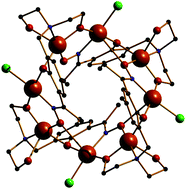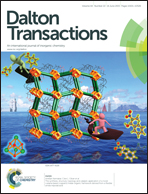Turning a “useless” ligand into a “useful” ligand: a magneto-structural study of an unusual family of CuII wheels derived from functionalised phenolic oximes†
Abstract
While the phenolic oximes (R-saoH2) are well known for producing monometallic complexes of the type [MII(R-saoH)2] with CuII ions in near quantitative yield, their derivatisation opens the door to much more varied and interesting coordination chemistry. Here we show that combining the complimentary diethanolamine and phenolic oxime moieties into one organic framework (H4L1 and H4L2) allows for the preparation and isolation of an unusual family of [CuII]n wheels, including saddle-shaped, single-stranded [CuII8] wheels of general formula [Cu8(HL1)4(X)4]n[Y] (when n = 0, X = Cl−, NO3−, AcO−, N3−; when n = 2+ X = (OAc)2/(2,2′-bpy)2 and Y = [BF4]2) and [Cu8(HL2)4(X)4] (X = Cl−, Br−), a rectangular [Cu6(HL1)4] wheel, and a heterometallic [Cu4Na2(HL1)2(H2L1)2] hexagon. Magnetic studies show very strong antiferromagnetic exchange between neighbouring metal ions, leading to diamagnetic ground states in all cases. DFT studies reveal that the magnitude of the exchange constants are correlated to the Cu–N–O–Cu dihedral angles, which in turn are correlated to the planarity/puckering of the [CuII]n rings.


 Please wait while we load your content...
Please wait while we load your content...